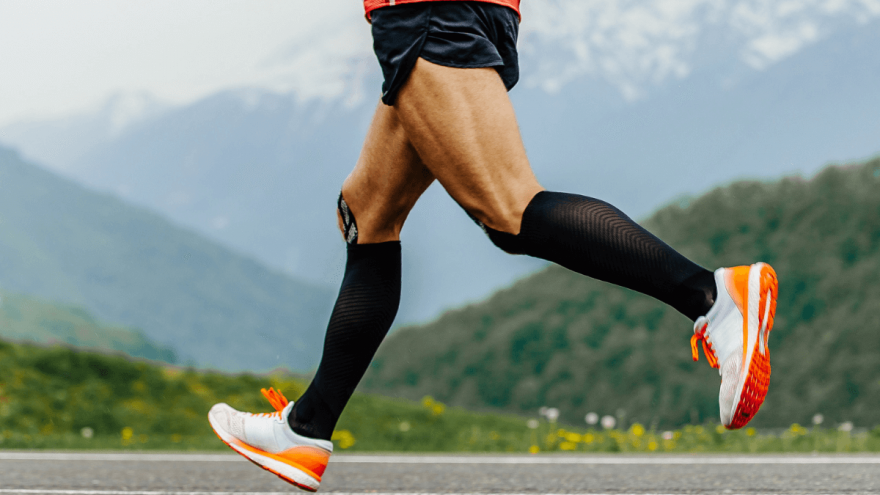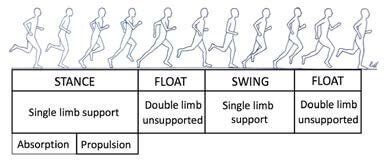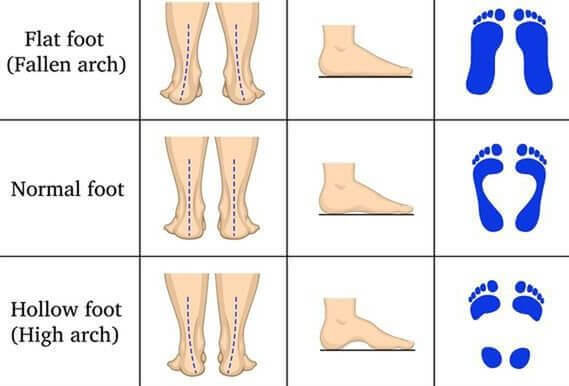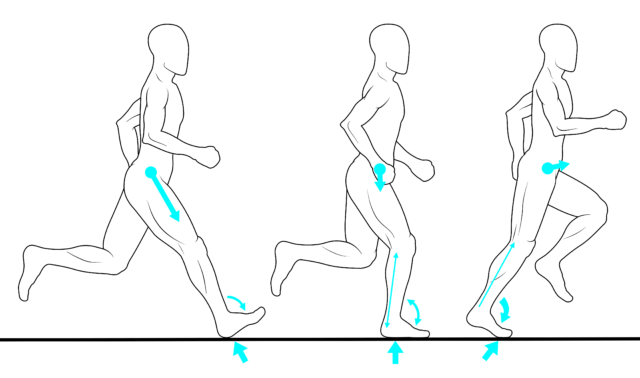Running Gait: How To Improve Your Running Gait

In order to deep dive into running gait, we sat down with two run-training experts. Let’s learn a little bit about these two before hearing what they have to say.
Jack McNamara, CSCS, MsC, Lead Tutor at Train Fitness: Since starting his career in 2005, Jack has delivered more than 20,000 hours of face-to-face coaching, worked at London’s most exclusive fitness facilities, and taught postgraduate exercise science courses to future leaders in strength coaching. He holds a master’s degree in Exercise for Special Populations and last year became one of the first personal trainers in the UK to ever be awarded Chartered status.
Brett Durney, PT and Owner of Fitness Lab: Co-Founder and Personal Trainer at Fitness Lab, he operates boutique personal training gyms in Soho and Fitzrovia in central London. Qualified as a PT, he has over 14 years of experience and has coached just under 17,000 PT sessions!
What Is Running Gait?
Running gait refers to the cycle our leg travels through when we take a step during running. This running gait cycle is comprised of two primary phases – the stance and the swing. Additionally, the float phase specifically separates running gait from walking gait: the two periods of float when neither foot is in contact with the ground.
The stance phase is divided into three sub-phases: initial contact, mid-stance, and propulsion. Initial contact is also known as the foot strike and it starts when your foot makes the first contact with the ground. This is the part that absorbs all of the impact.

Also known as the single support phase, mid-stance is the transition between absorbing the force and starting to propel your body forward. Lastly, propulsion is the final stage of the stance phase. Also known as the toe-off, your body starts to travel ahead.
As your foot leaves the ground and you flex at the ankle, knee, and hip, your foot gets enough clearance to clear the ground during this phase known as swing. This phase starts as soon as your foot leaves the ground and ends when you again make contact with your foot to the ground.
Durney has a great perspective on the topic, “What separates your running gait from your walking gait is the float stage, which occurs during the swing phase. This is the moment where neither foot is in contact with the floor and your body is ‘floating’ in the air.”
Why Does Running Gait Matter?
McNamara really hit the mark with this response. “For most of us, running is something we have “just done” since we were children, so we don’t actively pay attention to our posture, technique, or running rhythm. This can result in many runners carrying too much tension in their bodies and having an inappropriate stride length.
The result is often excessive force on the joints and a sensation of “crashing down” of their heels, which is why many casual runners would find it painful to run on a hard surface like pavement without their running shoes on.”
In other words, working on your gait could result in you running longer and stronger while avoiding injury.
How To Analyze Your Gait
An analysis of your running gait helps you to see how you are running. This will enable you to make the necessary corrections so that you are not running inefficiently. You can go to a professional to have a gait analysis done; however, it is also possible to do it on your own.
Using a video recording that will allow you to see yourself running from different angles will help you get the job done. A full analysis will include both frontal and side views.
According to Durney, there are some basic things to look for regarding both views.
1. Coach Durney’s Frontal View Key “Look For”
- Arms crossing the midline of the body
- Excessive trunk rotation
- Pelvis dropping to the opposite side of the stance leg
- Excessive forward rotation of the pelvis
- Alignment of the feet and knees
- Feet landing just inside the width of the pelvis
- Feet landing excessively rolled in or out
2. Coach Durney’s Side View Things to Look For
- Head upright and stable
- Arms flexing ahead and extending behind the torso
- Trunk rotating excessively
- Pelvis rotating forward excessively
- Foot landing in front of the body
- Knee bent on landing
- Trailing knee and ankle bending to prepare for leg swing
3. The Wet Test
Coach McNamara takes a different approach. According to McNamara, an important first step is determining what your feet do when you run. You can do the wet test to help you check your arch height.

“Wet both feet and stand on a strong piece of paper, like a paper bag, for about 10 seconds. When you step off, you can check the shape of the imprint your feet made on the bag.
- Normal arch – a clear curve along the inside of the imprint with a band along the outside edge of the foot connecting your heel and toe.
- Low arch – the imprint shows most of your foot, with not much curve along the inside edge.
- High arch – an exaggerated curve on the inside with a very thing band (or none at all) connecting the heel and toe.”
The wet test can help you hone in on the proper type of shoes for your individual feet.
Improving Your Running Gait
McNamara believes that “No matter what your running gait is, there isn’t really a reason to try and change it. Whilst there’s a seemingly endless number of running shoes and custom-made orthotics are available from most podiatrists, research published in the British Journal of Sports Medicine found no evidence to support the notion that foot pronation impacts the likelihood of running injury.
The best way for most people to avoid injury and improve their running economy is to prevent heel-striking or overstriding and pick up their running cadence instead.
Aiming to achieve more steps per minute (a higher cadence) often improves a runner’s overall form by encouraging shorter, smoother strides, reducing the vertical loading rate, and lowering the overall stress on the skeletal system.
That means less impact on the lower back, knees, and hips while maintaining a movement pattern that still occurs naturally for you and your physiology.”

Durney is a proponent of finding the problems in how you run and making adjustments to fix these things. According to Durney, “Making changes to your running gait can be tricky but it is possible. Chances are, any dysfunction in your gait has been reinforced by repetition. The thousands of strides you’ve taken from neuromuscular habits can be hard to break.
However, the key is to be more conscious of how you run. If there are a number of issues you need to address, tackle them one at a time. Trying to do too much at once is going to be ineffective. Pick the most pressing issue, work on that until it’s fixed then move on to the next.
Some running gait issues may not be things you can fix simply by being conscious of them when you run. Muscle imbalances, weaknesses, mobility issues, and injuries can also impact your gait.
Each body and each stride is unique, so you’ll get the most benefit from talking to a professional, such as a physical therapist or running coach, who can provide bespoke advice and programming.”
My Take as a Running Coach
My thoughts fall somewhere in between McNamara and Durney. I fully believe that a runner who is in the proper shoes will find themselves staying healthier, longer. Having said that, it does not necessarily mean that a runner with a certain type of arch has to be in a particular type of shoe.
I personally know runners with feet and running styles that convention would put into a stability shoe, and they are firm believers of the minimalist movement. And guess what? It works for them.
As a coach myself who worked with young people for most of my career, I do agree with Durney that if you are diligent, you can correct bad running mechanics. It is much easier to do this with young athletes than with adults who have run a certain way their entire life.
Having said that, I do believe that if a runner picks out a few things to change in their gait and/or running style, you can do so. Do I believe in a complete overhaul of the running style of a 40+-year-old runner? No. I don’t think that is necessary.
However, if you can identify just a few things to do differently to improve efficiency, why wouldn’t you?
Latest Articles
 Is Running on a Treadmill Easier Than Running Outside?Runners have their own preferences, whether it is treadmill running, running outside on the road, or exploring trails. So...
Is Running on a Treadmill Easier Than Running Outside?Runners have their own preferences, whether it is treadmill running, running outside on the road, or exploring trails. So... Is It OK to Use Trail Running Shoes on the Road?While trail running shoes can be used on roads, especially in situations where a runner encounters mixed terrains or pref...
Is It OK to Use Trail Running Shoes on the Road?While trail running shoes can be used on roads, especially in situations where a runner encounters mixed terrains or pref... How to Fix Sore Quads After Running?Rest, ice, gentle stretching, and over-the-counter pain relievers can help soothe sore quads after running. Also, ensure ...
How to Fix Sore Quads After Running?Rest, ice, gentle stretching, and over-the-counter pain relievers can help soothe sore quads after running. Also, ensure ... 10 Fruits With The Most Electrolytes to Replace Sports DrinksThese fruits are high in electrolytes such as potassium, magnesium, and calcium, essential for hydration, muscle function...
10 Fruits With The Most Electrolytes to Replace Sports DrinksThese fruits are high in electrolytes such as potassium, magnesium, and calcium, essential for hydration, muscle function...

